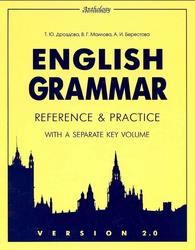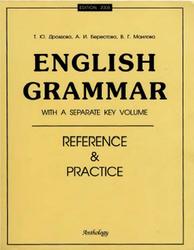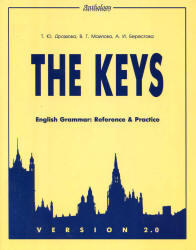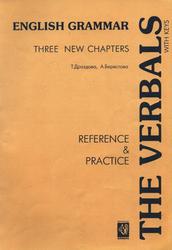Учебное пособие по грамматике английского языка для учащихся общеобразовательных учреждений с углубленным изучением английского языка и студентов ВУЗов.
Новое переработанное издание включает 16 тематических разделов, множество таблиц и примеров, свыше 800 упражнений, рассчитанных на разные уровни языковой подготовки, новые коммуникативные упражнения. Большинство упражнений выполнено в виде "рабочей тетради". Отдельной книгой изданы ответы-ключи The Keys.
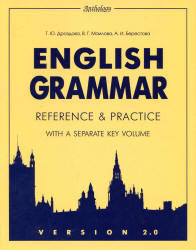
Примеры.
Translate into English.
1. Твой брат дома? 2. Сколько стоят эти открытки? 3. Эта гостиница очень дорогая. 4. Я интересуюсь искусством (be interested in). 5. Все магазины сегодня открыты. 6. Музей сегодня открыт? 7. Мне жарко. 8. Моя сестра - архитектор. 9. Я не устала. 10. Откуда родом её муж? 11. Они не студенты, они врачи. 12. Тебе интересны иностранные языки?
Answer the questions, using the Present Simple.
1. What time do you go to school? (generally, usually) 2. What do you do on Sunday mornings? (often) 3. How do you spend your leisure time? (usually, occasionally) 4. What sort of radio programmes do you listen to? (usually, often, always) 5. How do you help your parents? (always, sometimes, usually) 6. What sort of films do you enjoy? (nearly always) 7. Where do you read for your examinations? (normally, sometimes) 8. Where do you have your meals? (usually, sometimes) 9. What do you take if you have a headache?
(generally, usually) 10. How do you celebrate your birthday? (nearly always, occasionally).
CONTENTS
THE VERB
1. The Verb "to be" 9
2. "There + be" Construction 14
3. The Verb "to have" 17
4. English Tenses Active 21
5. The Simple Forms 23
5.1 The Present Simple Tense 23
5.2 The Past Simple Tense 26
5.3 The Future Simple Tense 32
6. The Continuous Forms 36
6.1 The Present Continuous Tense 36
6.2 The Present Continuous and the Present Simple 40
6.3 The Past Continuous Tense 42
6.4 The Past Continuous and the Past Simple 43
6.5 The Future Continuous Tense 47
6.6 Revision 49
7. Talking about the Future 50
7.1 Present Tenses with a Future Meaning 50
7.2 Be going to 51
7.3 The Future Simple 53
7.4 Be to, be about to, be due to 55
7.5 Revision 55
8. The Perfect Forms 58
8.1 The Present Perfect Tense 58
8.2 The Present Perfect and the Past Simple 64
8.3 The Past Perfect Tense 68
8.4 The Future Perfect Tense 73
9. The Perfect Continuous Forms 76
9.1 The Present Perfect Continuous Tense 76
9.2 The Present Continuous and the Present Perfect Continuous 78
9.3 The Present Perfect and the Present Perfect Continuous 79
9.4 Revision 81
9.5 The Past Perfect Continuous Tense 83
9.6 The Past Continuous and the Past Perfect Continuous 85
9.7 The Future Perfect Continuous Tense 86
10. Revision on Tenses 87
11. Tests 93
MODAL VERBS
1. Definition 95
2. "Can" 95
2.1 Can - to Express Strong Doubt or Astonishment 99
2.2 Revision 101
3. "May" 102
3.1 May- to Express Uncertainty, Strong Doubt 103
4. "Must" 106
4.1 Must-to Express Probability, Near Certainty 109
4.2 Revision 113
5. "Should" and "Ought to" 114
6. "Need" 117
7. Revision 121
8. Tests 124
THE PASSIVE VOICE
1. Formation of the Passive Voice 126
2. Uses of the Passive Voice Peculiar to the English Language 127
3. Revision 136
4. Tests 138
QUESTIONS AND NEGATIVES 140
THE SEQUENCE OF TENSES
1. General Rules 146
2. Revision 150
3. Tests 152
DIRECT AND INDIRECT SPEECH
1. Indirect Statement 153
2. Indirect Command and Request 155
3. Indirect Questions 156
3.1 Indirect General Questions 156
3.2 Indirect Special Questions 157
4. Reporting a Dialogue or a Conversation 158
5. Revision 161
THE SUBJUNCTIVE MOOD
1. Conditional Sentences 165
1.1 Revision 172
1.2 Test 175
2. Making a Wish 175
3. Revision 179
4. Tests 180
THE NOUN
1. Formation of Nouns 181
2. Classification of Nouns 184
3. The Category of Number 187
4. The Category of Case 191
5. Tests 195
THE ARTICLE
1. Use of Articles with Common Nouns 196
1.1 Revision 202
2. Use of Articles with Nouns of Material and Abstract Nouns 205
3. Use of Articles with Proper Nouns 208
3.1 Geographical Names 208
3.2 Use of Articles in the Names of Places, Buildings, Public Organizations, etc 210
3.3 Names of Persons 212
4. Special Difficulties in the Use of Articles 214
4.1 Use of Articles with the Names of Months and Days, Seasons, Meals, Languages,
Nouns: Day, Night, Evening, Morning, etc 214
4.2 Use of Articles with the Nouns School/College, Prison/Jail, Bed, Town, Church 216
4.3 Revision 218
5. Use of Articles in Some Set Expressions 219
6. Tests 221
THE PRONOUN
1. Classification of Pronouns 223
1.1 Personal and Possessive Pronouns 223
1.2 Reflexive Pronouns 226
1.3 Demostrative Pronouns 228
1.4 Interrogative Pronouns 230
1.5 Defining Pronouns 231
1.6 Indefinite and Negative Pronouns 236
1.7 Much/Many, Little/Few, a Little/a Few 243
2. Tests 246
THE ADJECTIVE
1. Formation of Adjectives 247
2. Word Order: Adjective + Noun 250
3. The Comparison of Adjectives 253
4. Tests 261
THE ADVERB
1. Definition, Forms and Place 262
2. Classification of Adverbs 267
2.1 Adverbs of Manner 267
2.2 Adverbs of Time 269
2.3 Adverbs of Frequency 271
2.4 Adverbs of Place and Direction 272
2.5 Adverbs of Degree, Measure and Quantity 273
2.6 Viewpoint Adverbs 279
3. Revision 280
4. Tests 282
THE VERBALS (the non-finite forms of the verb)
1. The Gerund 283
1.1 Forms / Use of the Gerund 283
1.2 Tense/ Voice Distinctions of the Gerund 289
1.3 Verbs Used with the Gerund and the Infinitive 292
1.4 The Gerundial Construction 296
1.5 Revision 298
1.6 Tests 300
2. The Infinitive 302
2.1 Forms. Tense / Voice Distinctions 302
2.2 Use of the Infinitive without the Particle to 303
2.3 Functions of the Infinitive in the Sentence 306
2.3.1 Revision 313
2.4 The Infinitive Constructions 314
2.4.1 The Complex Object 314
2.4.2 The Complex Subject 320
2.4.3 The for-to-lnfinitive Construction 328
2.5 Revision 331
2.6 Tests 333
3. The Participle 334
3.1 Forms and Functions 334
3.2 Functions of the Participle in the Sentence 336
3.3 Have Something Done 345
3.4 The Absolute Participial Construction 346
3.5 Revision 347
3.6 Tests 348
THE PREPOSITION
1. Definition 350
2. Prepositions of Place 351
2.1 Prepositions of Place at, in, on 353
3. Prepositions of Direction 355
4. Some Prepositions Confused 359
5. Revision 362
6. Prepositions with Forms of Transport 363
7. The Prepositions of Time 364
7.1 Prepositions for, during, while 365
7.2 Prepositions before, till/until, by 367
7.3 Prepositions since, from, in time/on time 368
8. Prepositions Expressing Abstract Relations 370
8.1 Prepositions by, with 370
8.2 As and like 371
8.3 About, on 371
9. Composite Prepositions 372
10. Revision 373
11. Use of Prepositions in Set Expressions 374
12. Tests 375
THE COMPOUND SENTENCE AND THE COMPLEX SENTENCE
1. The Compound Sentence 377
2. The Complex Sentence 377
2.1. Subject Clauses 378
2.2. Predicative Clauses 379
2.3. Object Clauses 380
2.4. Attributive Clauses 381
2.4.1 Defining and Non-Defining Relative Clauses 382
2.4.2 Subject and Object Relative Clauses 382
2.4.3 Which Referring to the Whole Sentence 385
2.4.4 Clauses Introduced by What, That, Which 386
Revision 387
2.5. Adverbial Clauses 389
2.5.1 Time Clauses 389
2.5.2 Adverbial Clauses of Place 392
2.5.3 Adverbial Clauses of Manner 392
2.5.4 Purpose and Reason Clauses 394
2.5.5 As and since in Clauses of Time and Cause (Reason) 395
Revision 396
2.5.6 Contrast Clauses 396
2.6 Revision 398
2.7 Tests 399
EMPHASIS
1. The Emphatic "Do" 401
2. Double Negation 402
3. The Emphatic Construction "It is ... that/which/who/whom" 402
4. The Emphatic Construction "It is not until... that" 403
5. The Emphatic "Not ...till/until" 404
6. Tests 405
APPENDICES
Appendix 1. List of Grammar Terms and Keywords 406
Appendix 2. List of Irregular Verbs 411
Appendix3. Irregular and Regular Verbs: Confusing Forms 414
Appendix 4. Regular Verbs: Spelling Rules 415
Appendix 5. Place and Order of Adverbs in a Sentence 416
Appendix 6. American English 417
Appendix 7. Punctuation 417
Appendix 8. Prepositions and Homonymous Adverbs. Meaning and Use 420
Literature 423.
Купить книгу English Grammar, Reference and Practice, Version 2, Дроздова Т.Ю., Маилова В.Г., Берестова А.И., 2012 .
Купить книгу English Grammar, Reference and Practice, Version 2, Дроздова Т.Ю., Маилова В.Г., Берестова А.И., 2012 .
По кнопкам выше и ниже «Купить бумажную книгу» и по ссылке «Купить» можно купить эту книгу с доставкой по всей России и похожие книги по самой лучшей цене в бумажном виде на сайтах официальных интернет магазинов Лабиринт, Озон, Буквоед, Читай-город, Литрес, My-shop, Book24, Books.ru.
По кнопке «Купить и скачать электронную книгу» можно купить эту книгу в электронном виде в официальном интернет магазине «Литрес», и потом ее скачать на сайте Литреса.
По кнопке «Найти похожие материалы на других сайтах» можно найти похожие материалы на других сайтах.
On the buttons above and below you can buy the book in official online stores Labirint, Ozon and others. Also you can search related and similar materials on other sites.
Хештеги: #учебник по английскому языку :: #английский язык :: #Дроздова :: #Маилова :: #Берестова
Смотрите также учебники, книги и учебные материалы:
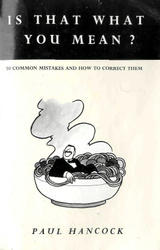 50 типичнейших ошибок у изучающих английский язык — Paul Hancock. 1990. В книге анализируются 50 типичнейших ошибок, которые чаще всего допускают изучающие английский язык (control vs. check, boring … Книги по английскому языку
50 типичнейших ошибок у изучающих английский язык — Paul Hancock. 1990. В книге анализируются 50 типичнейших ошибок, которые чаще всего допускают изучающие английский язык (control vs. check, boring … Книги по английскому языку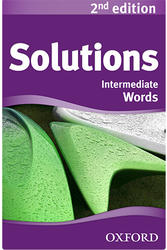 Solutions Intermediate, Student’s Book, 2012 — Solutions 2nd edition Intermediate, Student s Book, 2012. Уровень рассчитан на 100-120 учебных часов, с учетом работы со всеми заданиями. … Книги по английскому языку
Solutions Intermediate, Student’s Book, 2012 — Solutions 2nd edition Intermediate, Student s Book, 2012. Уровень рассчитан на 100-120 учебных часов, с учетом работы со всеми заданиями. … Книги по английскому языку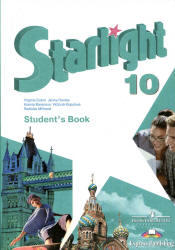 Английский язык, Starlight, 10 класс, Баранова К.М., Дули Д., Копылова В.В., 2012 — Линия УМК Звездный английский (10-11) Учебник (Student’s Book) является основным компонентом УМК Звёздный английский и предназначен для учащихся 10 класса … Книги по английскому языку
Английский язык, Starlight, 10 класс, Баранова К.М., Дули Д., Копылова В.В., 2012 — Линия УМК Звездный английский (10-11) Учебник (Student’s Book) является основным компонентом УМК Звёздный английский и предназначен для учащихся 10 класса … Книги по английскому языку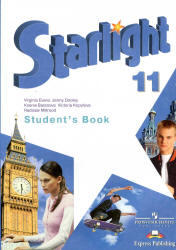 Английский язык, Starlight, 11 класс, Баранова К.М., Дули Д., Копылова В.В., 2011 — Линия УМК Звездный английский (10-11 классы) (Углубленный) . Учебник (Student’s Book) является основным компонентом УМК Звёздный английский и предназначен для … Книги по английскому языку
Английский язык, Starlight, 11 класс, Баранова К.М., Дули Д., Копылова В.В., 2011 — Линия УМК Звездный английский (10-11 классы) (Углубленный) . Учебник (Student’s Book) является основным компонентом УМК Звёздный английский и предназначен для … Книги по английскому языку
 Английский язык, Happy English ru, 2 класс, аудиокурс MP3, Кауфман К.И., 2011 — Счастливый английский.ру для 2-го класса входит в состав завершенной предметной линии Happy English.ru для 2-11-х классов основного общего образования. УМК … Книги по английскому языку
Английский язык, Happy English ru, 2 класс, аудиокурс MP3, Кауфман К.И., 2011 — Счастливый английский.ру для 2-го класса входит в состав завершенной предметной линии Happy English.ru для 2-11-х классов основного общего образования. УМК … Книги по английскому языку Английский язык, Happy English ru, 2 класс, часть 2, Кауфман К.И., Кауфман М.Ю., 2012 — УМК Счастливый английский.ру для 2-го класса входит в состав завершенной предметной линии Happy English.ru для 2-11-х классов основного общего образования. … Книги по английскому языку
Английский язык, Happy English ru, 2 класс, часть 2, Кауфман К.И., Кауфман М.Ю., 2012 — УМК Счастливый английский.ру для 2-го класса входит в состав завершенной предметной линии Happy English.ru для 2-11-х классов основного общего образования. … Книги по английскому языку Английский язык, Happy English ru, 2 класс, часть 1, Кауфман К.И., Кауфман М.Ю., 2011 — УМК Счастливый английский.ру для 2-го класса входит в состав завершенной предметной линии Happy English.ru для 2-11-х классов основного общего образования. … Книги по английскому языку
Английский язык, Happy English ru, 2 класс, часть 1, Кауфман К.И., Кауфман М.Ю., 2011 — УМК Счастливый английский.ру для 2-го класса входит в состав завершенной предметной линии Happy English.ru для 2-11-х классов основного общего образования. … Книги по английскому языку Приложение Enjoy the ABC к учебнику Enjoy English для 2 класса, 2008 — Мультимедиа приложение к учебнику Enjoy English для 2 класса. Цель данного приложения- помочь детям выучить английский алфавит. Программу можно использовать … Книги по английскому языку
Приложение Enjoy the ABC к учебнику Enjoy English для 2 класса, 2008 — Мультимедиа приложение к учебнику Enjoy English для 2 класса. Цель данного приложения- помочь детям выучить английский алфавит. Программу можно использовать … Книги по английскому языку

